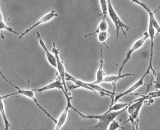Schwann Cells (SC)
Neurolemmocytes

Schwann cells or neurolemmocytes are the principal glia of the peripheral nervous system (PNS). Glial cells function to support neurons and in the PNS, also include satellite cells, olfactory ensheathing cells, enteric glia and glia that reside at sensory nerve endings, such as the Pacinian corpuscle. The Schwann cell promoter is present in the downstream region of the human dystrophin gene that gives shortened transcript that are again synthesized in a tissue specific manner.
Schwann cells are involved in many important aspects of peripheral nerve biology - the conduction of nervous impulses along axons, nerve development and regeneration, trophic support for neurons, production of the nerve extracellular matrix, modulation of neuromuscular synaptic activity, and presentation of antigens to T-lymphocytes. Charcot–Marie–Tooth disease (CMT), Guillain–Barré syndrome, schwannomatosis, and chronic inflammatory demyelinating polyneuropathy (CIDP), and leprosy are all neuropathies involving Schwann cells.
Organism species: Homo sapiens (Human)
- Customized Service n/a Schwann Cells (SC) Primary Cells Customized Service Offer
- Customized Service n/a Extract of Schwann Cells (SC) Total Protein/DNA/RNA Extract Customized Service Offer
- Customized Service n/a Medium for Schwann Cells (SC) (If Necessary) Cell Culture Medium Customized Service Offer
Organism species: Mus musculus (Mouse)
- Cell CSI038Mu01 Primary Mouse Schwann Cells (SC) In Stock
- Customized Service n/a Extract of Schwann Cells (SC) Total Protein/DNA/RNA Extract Customized Service Offer
- Medium MSI038Mu11 Medium for Mouse Schwann Cells (SC) In Stock
Organism species: Rattus norvegicus (Rat)
- Cell CSI038Ra01 Primary Rat Schwann Cells (SC) In Stock
- Customized Service n/a Extract of Schwann Cells (SC) Total Protein/DNA/RNA Extract Customized Service Offer
- Medium MSI038Ra11 Medium for Rat Schwann Cells (SC) In Stock
Organism species: Cavia (Guinea pig )
- Customized Service n/a Schwann Cells (SC) Primary Cells Customized Service Offer
- Customized Service n/a Extract of Schwann Cells (SC) Total Protein/DNA/RNA Extract Customized Service Offer
- Customized Service n/a Medium for Schwann Cells (SC) (If Necessary) Cell Culture Medium Customized Service Offer
Organism species: Oryctolagus cuniculus (Rabbit)
- Cell CSI038Rb01 Primary Rabbit Schwann Cells (SC) In Stock
- Customized Service n/a Extract of Schwann Cells (SC) Total Protein/DNA/RNA Extract Customized Service Offer
- Medium MSI038Rb11 Medium for Rabbit Schwann Cells (SC) In Stock
Organism species: Canis familiaris; Canine (Dog)
- Cell CSI038Ca01 Primary Canine Schwann Cells (SC) In Stock
- Customized Service n/a Extract of Schwann Cells (SC) Total Protein/DNA/RNA Extract Customized Service Offer
- Customized Service n/a Medium for Schwann Cells (SC) (If Necessary) Cell Culture Medium Customized Service Offer


